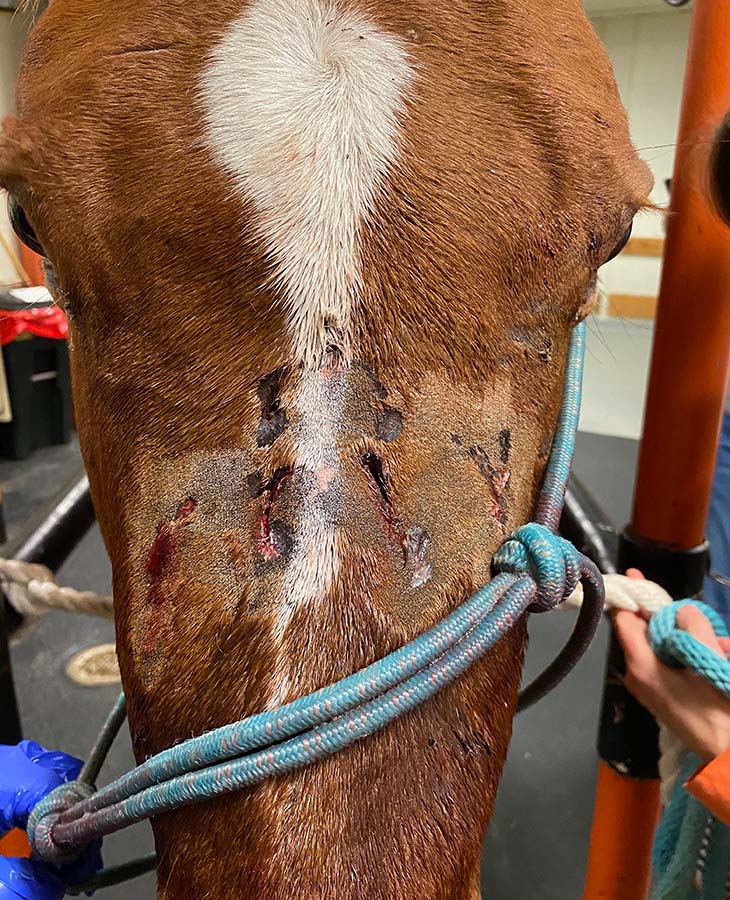
Now That’s a Headache: Facial trauma and fractures in horses
Tuesday, October 5, 2021
Many horses can cause trauma on themselves. Usually, those are wounds or cuts on the legs — but sometimes, they’re on the horse’s head.
Head wounds can be simple lacerations involving only the skin and requiring a few sutures from your veterinarian. Lacerations involving the eyelids, nostrils or lips are more challenging to repair with a cosmetic, functional outcome. Things get more complex when the trauma is severe enough to fracture facial bones — the boney orbit protecting the eye, the nasal bones overlying the nasal passages or the bones overlying the paranasal sinuses. These types of fractures often result in multiple small pieces, a bit like a jigsaw puzzle.
If you suspect that your horse has fractures and/or trauma to the bones of the skull, have your veterinarian examine the horse as soon as possible. With these injuries, you might notice cuts or breaks in the skin overlying the fractures, and some of the fracture fragments may be visible. If there is not a break in the skin and there are fractures involving the sinuses, air may accumulate beneath the skin, termed emphysema. Fractures involving the sinuses and/or nasal passages usually exhibit bleeding from the nose on the affected side(s). Swelling of varying degrees may be noticeable as well, particularly if the injury is more than a few hours old.
An initial examination of the horse by your veterinarian will likely include a thorough physical examination, sedation and gentle cleaning and palpation of the wounds. Radiographs of the skull may be taken to get a better idea of which bone(s) are involved and the extent of the fractures. Fractures that involve the nasal passages, particularly if both sides of the nose are affected, can result in swelling severe enough to impair breathing. For these cases, a temporary tracheostomy (temporary opening in the trachea with placement of a tube for the horse to breathe through) may be needed.
Treatment course depends on the severity and extent of the injuries. Less extensive fractures with minimal displacement may warrant only repair of the skin lacerations, allowing the fractures to heal on their own. Surgical repair of the fracture fragments, usually under general anesthesia, may be recommended for more extensive fractures of the sinuses and nasal passages. Fractures involving the boney orbit surrounding the eye typically require surgical fixation as well. In very severe cases, advanced imaging in the form of a CT scan may be recommended before going to surgery, to obtain prognostic information for the horse and to help the surgeon plan for the repair.
Surgical repair of skull or facial fractures has been accomplished via a variety of methods. Often, we use larger sutures or stainless steel wire to reattach the fragments. In some cases, small reconstructive bone plates are used. Very small pieces of bone may need to be discarded if they can’t be wired into place. If left where they are, these will likely die and become a source for drainage. If the sinus cavities are involved, a thorough lavage of the sinus cavities will be performed. Bleeding into the sinuses that occurs with facial trauma sets up a nice environment for bacterial infection to occur, so a thorough lavage of the sinuses, or at least a course of broad spectrum antibiotics, is often indicated. Once the fracture fragments have been repaired, skin wounds can be closed.
Recovery for skull or facial fracture patients can be tricky. We want to minimize additional trauma to the head and keep the horse from rubbing its face on the stall, fence, etc., to avoid harming the delicate repair. As previously mentioned, the horse will likely be placed on broad-spectrum antibiotics, as well as Bute or Banamine for pain.
Following facial trauma, a number of complications that may occur and warrant additional treatment include: secondary sinus infection, sequestration of bone fragments (where small pieces of bone become devitalized and act as a source of drainage), and fistula formation (due to incomplete healing of bone, a communication forms between the skin and the sinus). In very severe cases, neurologic symptoms such as dull mentation or incoordination may occur, indicating a poorer prognosis for the patient and warranting additional diagnostics and treatments.
Many facial fractures heal well and relatively cosmetically with early and appropriate treatment. Contacting your veterinarian right away gives your horse the best chance for a successful recovery.
About the author: Megan Williams, DVM, DACVS (Large Animal) is an assistant professor of equine surgery at Oklahoma State University’s College of Veterinary Medicine. She is board-certified in large animal surgery and a diplomate of the American College of Veterinary Surgeons (Large Animal). Her research interests include equine lameness, particularly regarding suspensory ligament pathology.
Veterinary Viewpoints is provided by the faculty of the OSU Veterinary Medical Hospital. Certified by the American Animal Hospital Association, the hospital is open to the public providing routine and specialized care for all species and 24-hour emergency care, 365 days a year. Call 405-744-7000 for an appointment or more information.
OSU’s College of Veterinary Medicine is one of 32 accredited veterinary colleges in the United States and the only veterinary college in Oklahoma. The college’s Boren Veterinary Medical Hospital is open to the public and provides routine and specialized care for small and large animals. The hospital offers 24-hour emergency care and is certified by the American Animal Hospital Association. For more information, visit https://vetmed.okstate.edu or call 405-744-7000.
